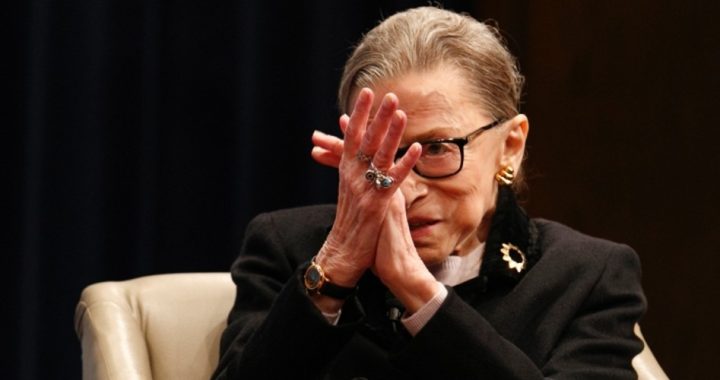
The oldest member of the Supreme Court, Justice Ruth Bader Ginsburg, returned home on Sunday after having been hospitalized on Friday with a fever. A court spokesman said she is at home and “doing well.”
She’ll be 87 in March and has suffered a long series of health issues. Last fall, she fractured three ribs after falling in her office. She has undergone surgery for lung cancer and radiation treatment for pancreatic cancer. This follows surgery she underwent in 2009 for early stage pancreatic cancer and treatment for colon cancer in 1999.
Despite these issues, she is determined to remain active “as long as I can do it full steam,” she said.
She’d also like to outlive Trump’s first term in office so that he can’t nominate someone to replace her. In July 2016, three months before Trump was elected president, Ginsburg told the New York Times: “I can’t imagine what this place would be — I can’t image what the country would be — with Donald Trump as our president. For the country, it could be four years. For the court, it could be … I don’t even want to contemplate that.”
It’s time to contemplate that.
The Supreme Court has ultimate appellate jurisdiction over all federal and state cases that involve a point of federal law. It holds the power of judicial review, i.e., the power to invalidate a statute that violates a provision of the U.S. Constitution. It’s a key part of the “checks and balances” and “separation of powers” doctrines the founders built into that document to keep the three legislative branches of the federal government in check.
The war over the Supreme Court nominees comes down to how they view the Constitution. Originalists, to put things simply, interpret the Constitution based on the original understanding of the authors and the citizenry at the time it was ratified. It’s the view that the Constitution has a fixed meaning and that interpretation of the document should be based on what people living at the time of its adoption would have understood the ordinary meaning of the text to be.
Originalism, in other words, deters judges from injecting their personal opinions into constitutional interpretation.
This contrasts with the progressives’ notion that the Constitution is a “living” document and that it should be interpreted based on the context of the present times, even if such interpretation turns the original meaning of Constitution on its head.
For instance, Justice Stephen Breyer believes that applying the “living” document approach allows him (and by inference, Ginsburg) to look more closely not so much at the language of the Constitution for guidance, but at a ruling’s “purpose and consequences.”
This “living” document approach has led Ginsburg astray. In January 2012, during a visit to Cairo, Egypt, she advised the nation to ignore the U.S. Constitution for guidance in drafting its own new constitution. She declared that she “would not look to the U.S. Constitution if I were drafting a new constitution in 2012.” It is just too “old,” she said.
Instead, she lavished praise on the South African constitution, Canada’s Charter of Rights and Freedoms, and the European Convention on Human Rights.
The contrast between Ginsburg’s view of the document and that of the Federalist Society — the group that assisted greatly in the development of a list of potential nominees to U.S. courts for President Trump — couldn’t be greater. Instead of writing off the U.S. Constitution as “old” and irrelevant to the present day, the Federalist Society is “founded on the principles that the state exists to preserve freedom, that the separation of governmental power is central to our Constitution, and that it is emphatically the province and duty of the judiciary to say what the law is, not what it should be.”
When Ginsburg leaves the bench, which could be very soon, the president will have the opportunity to name an individual to replace her. If it’s President Trump who does the nominating, the progressive Left will do anything — including besmirching the character of that nominee — to keep the president from putting more originalists on the federal bench and to discourage potential nominees from even considering the position.
In Justice on Trial: The Kavanaugh Confirmation and the Future of the Supreme Court, authors Mollie Hemingway and Carrie Severino warn:
When the justices took their seats behind the bench [following the confirmation of Justice Kavanaugh], one was missing. Ruth Bader Ginsburg, at eighty-six the Court’s oldest member, was in the hospital. She had fallen the day before, breaking three ribs. Her doctors then discovered a cancerous mass in her lung, her third bout with cancer.… Sooner or later there will be another vacancy on the Court, whether it is her seat or another justice’s.
It’s hard to imagine how a confirmation battle could compete with Kavanaugh’s for ugliness. But if the next appointment portends a major ideological shift, it could be worse….
Vicious confirmation battles will unfortunately dissuade the best Americans from being considered for the nation’s judiciary… One of Kavanaugh’s colleagues says the process is so tough that it isn’t worth it.
The progressive Left is at war with America. It sees its opportunity to change the culture through the Supreme Court slipping away. Whoever is nominated to fill the next vacancy will have to be made of stern stuff to withstand the slings and arrows the Left will launch to keep him or her off the bench.
Photo: AP Images
An Ivy League graduate and former investment advisor, Bob is a regular contributor to The New American, writing primarily on economics and politics. He can be reached at [email protected].
Related articles:
Senate Dems Threaten to Pack the Supreme Court; Republicans Say No
GOP Senate Invokes “Nuclear Option” to Clear Backlog of Judicial Appointees
Presidential Milestone: Trump Has Confirmed Over 150 Federal Judges



